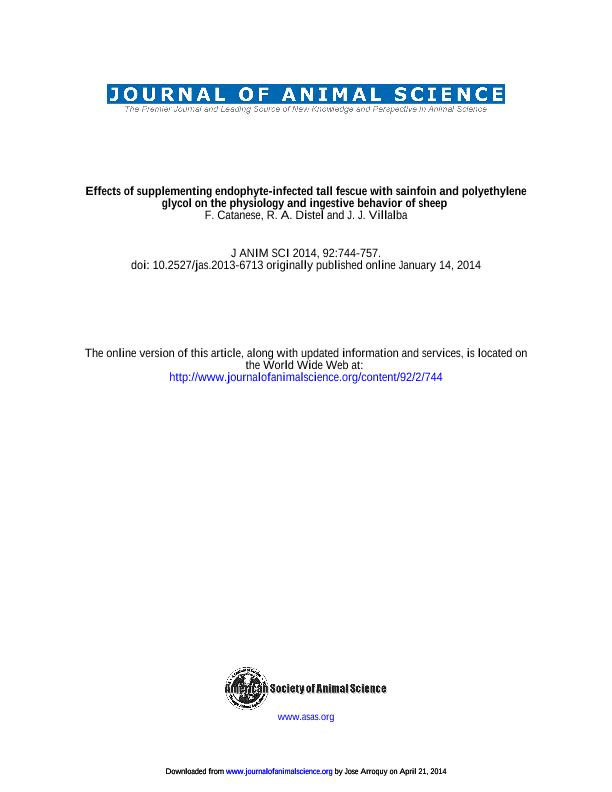Artículo
Effects of supplementing endophyte-infected tall fescue with sainfoin and polyethylene glycol on the physiology and ingestive behavior of sheep
Fecha de publicación:
02/2014
Editorial:
American Society Of Animal Science
Revista:
Journal Of Animal Science
ISSN:
0021-8812
Idioma:
Inglés
Tipo de recurso:
Artículo publicado
Clasificación temática:
Resumen
Tannins in sainfoin (Onobrychis viciifolia) may bind to alkaloids in endophyte-infected tall fescue [E+; Lolium arundinaceum (Schreb.) Darbysh.] and attenuate toxicosis. If so, supplementing E+ with sainfoin will increase use of E+ by sheep, and polyethylene glycol (PEG)—a polymer that selectively binds to tannins—will reduce such response. To test these predictions, thirty-six 2-mo-old lambs were randomly assigned to 3 treatments (12 lambs/treatment). During exposure, all lambs were individually penned and fed E+ supplemented with beet pulp (CTRL), freshcut sainfoin and beet pulp (SAIN), or fresh-cut sainfoin plus PEG mixed in beet pulp (SAIN+PEG). Feed intake was measured daily. Rectal temperatures and jugular blood samples were taken at the beginning and end of exposure. After exposure, all lambs were offered choices between endophyte-free tall fescue (E–) and orchardgrass, and preference for E– was assessed. Then, all lambs were allowed to graze a choice of E+ and sainfoin or a monoculture of E+. The foraging behavior of lambs was recorded. When sainfoin was in mid-vegetative stage, lambs in SAIN ingested more E+ than lambs in CTRL (P = 0.05), but no differences were detected between lambs in SAIN+PEG and CTRL (P = 0.12). Sainfoin supplementation improved some physiological parameters indicative of fescue toxicosis. Lambs in SAIN had lower rectal temperatures (P = 0.02), greater numbers of leukocytes (P < 0.001) and lymphocytes (P = 0.03), and greater plasmatic concentrations of globulin (P = 0.009) and prolactin (P = 0.019) than lambs in CTRL. Some of these differences were offset by the SAIN+PEG treatment. When lambs were offered choices between E– and orchardgrass, only lambs in SAIN had greater intake of E– than lambs in CTRL (P < 0.001). When lambs were allowed to graze a choice of E+ and sainfoin, all treatments used E+ to the same extent (P > 0.05). On the other hand, when they grazed on a monoculture of E+, lambs in SAIN+PEG showed greater acceptance of E+ than lambs in SAIN or in CTRL (P < 0.05). In summary, sainfoin supplementation alleviated several of the classic signs of fescue toxicosis and increased intake of endophyte-infected tall fescue. Tannins in sainfoin partially accounted for this benefit since feeding a polymer that selectively binds to tannins (PEG) attenuated some these responses. However, sainfoin supplementation during initial exposure to E+ did not lead to an increased preference for E+ during grazing.
Palabras clave:
Alkaloids
,
Condensed Tannins
,
Fescue Toxicosis
,
Ingestive Behavior
,
Sainfoin
,
Sheep
Archivos asociados
Licencia
Identificadores
Colecciones
Articulos(CERZOS)
Articulos de CENTRO REC.NAT.RENOVABLES DE ZONA SEMIARIDA(I)
Articulos de CENTRO REC.NAT.RENOVABLES DE ZONA SEMIARIDA(I)
Citación
Catanese, Francisco Hernan; Distel, Roberto Alejandro; Villalba, Juan Jose; Effects of supplementing endophyte-infected tall fescue with sainfoin and polyethylene glycol on the physiology and ingestive behavior of sheep; American Society Of Animal Science; Journal Of Animal Science; 92; 2; 2-2014; 744-757
Compartir
Altmétricas




